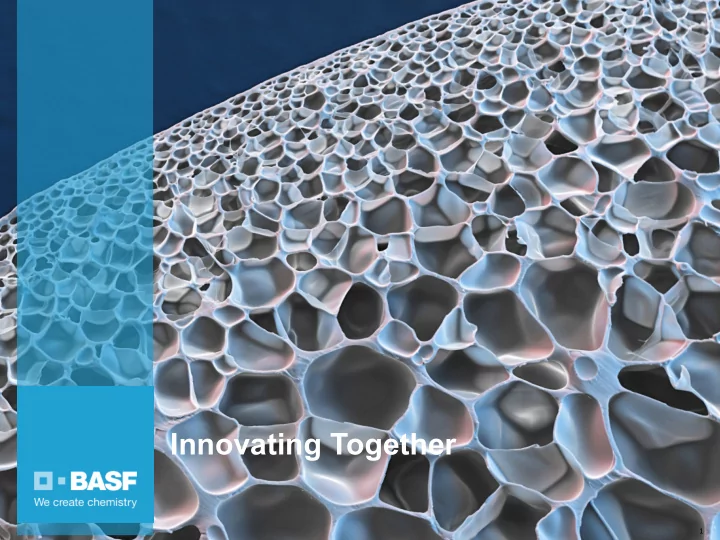

Innovating Together 1
150 Jahre BASF – We create chemistry n Our chemistry is used in almost all industries n We combine economic success, social responsibility and environmental protection n Sales 2016: € 57,550 million n EBIT 2016: € 6,275 million n Employees: 113,830 (as of December 31, 2016) n 6 Verbund sites and 352 other production sites 2
150 years BASF’s segments Functional Chemicals Performance Functional Agricultural Oil & Gas Materials & Products Materials & Solutions Solutions Solutions Petrochemicals Dispersions & Catalysts Crop Oil & Gas Pigments Protection Monomers Construction Care Chemicals Chemicals Intermediates Nutrition & Coatings Health Performance Performance Materials Chemicals 3
150 years 2016 sales* and EBIT in the regions Million € 47% North America Europe Sales 14,682 Sales 27,221 Sales EBIT 1,113 EBIT 3,632 BASF Group 57,550 26% 20% 7% South America, Africa, Middle East Asia Pacific Sales 4,135 Sales 11,512 EBIT 432 EBIT 1,098 * By location of company . 4
150 Jahre Chemicals – a growth industry Global annual growth rate of ~3.6%* Agriculture Health & Energy & Construction Consumer Transportation Electrical nutrition resources & housing goods & electronics Chemistry as enabler to meet current and future needs ~10bn 70% 50% 30% … of the world population … more food needed … people by 2050 … more primary energy will live in cities by 2050 by 2050 consumption by 2050 5 * Average annual real change 2017-2019; BASF Report 2016 p.121
150 Jahre Innovation – meeting challenges, developing new business areas Research for the future: With our innovative products and processes, we provide sustainable solutions for global needs. n Expenditures for research and development 1 6 € 1,863 million, world leader in 2 € 1.863 chemical industry 5 billion n Around 10,000 employees worldwide 4 3 involved in research and development 1 Chemicals n Around 3,000 research projects 10% 2 Performance Products n Around 850 new patents filed 20% 3 Functional Materials & Solutions 21% 4 Agricultural Solutions 26% 5 Oil & Gas 6 2%
150 Jahre Global Know-How Verbund Three global Technology Platforms headquartered in key markets Operating Customers High-tech Industry partners Divisions joint ventures Europe, North America, Asia- Pacific Advanced Materials & Close connection with Systems Research the development units in Technology New Business & Bioscience Research Excellence Venture Capital the Operating Divisions Process Research & Chemical Engineering Global Know-How Verbund and global network with around Innovation Research Universities Management institutions 600 universities, research institutions and companies 7
150 Jahre Advanced Materials & Systems Research Construction Dispersions & Structural Polymer Material Performance Care & Coating Colloidal Materials & Processing & Physics Materials Materials Materials Materials Systems Engineering & Analytics
150 Jahre Bioscience Research n White biotechnology n Methods to produce more efficient products while consuming fewer resources n Targeted change metabolism of microorganisms n New, sustainable processes for mass producing microorganisms n Chemical manufacturing from renewable resources n BASF Enzymes n Patented and proprietary technology for the discovery of novel, unique enzymes n Comprehensive protein engineering tools n World-class facilities for enzyme scale-up n Enhancing crop efficiency n Transfer of genes with desirable traits into crops for: n Better yield and stress tolerance n Improved herbicide tolerance n Better disease and pest resistance
150 Jahre Process Research / Chemical Engineering n Process and application design innovation n Constantly developing and improving the synthesis of various basic chemicals, intermediates and fine chemicals as well as monomers, solvents and aroma chemicals n Process engineering: solids and fluids processing; high temperature engineering; safety engineering; fluid mechanics n Catalysis research n Heterogeneous and homogeneous catalysis n Electrochemistry and batteries n High throughput experimentation n New materials and systems n Metal organic frameworks (MOFs) n Nanomaterials n Mineral processing
150 Jahre Focus Areas of Key Technology Capabilities Selected Key Technology Capabilities reflect where BASF requires continued effort and resources to safeguard todays and tomorrows excellence in innovation. Biotechnology Catalysis Polymer Enabling Materials Technologies Methods The Key Technology Biodegradable Production & Biobased Capabilities are bundled Processes Materials in seven Focus Areas 11
150 Jahre Digitalization in R&D Bundling Competencies § Computational § Materials Process & Chemistry Molecular Modeling § Bioinformatics § Quantum Chemistry § Systems Biology § Molecular § Biostatistics Simulation § Chemical Process § Data Sciences Modeling § New Solutions § Computational § Knowledge & Fluids Dynamics Information Methods
150 Jahre What BASF Needs 13
150 Jahre BASF Needs: Additives n Fast-fusing sustainable plasticizers for flexible PVC applications n Halogen-free flame retardants for polyolefins / thermoplastics n Antioxidants with chemical resistance to chlorine oxidizing in plastics n New Antioxidant chemistry and/or technologies beyond traditional phenols, phosphites, amines, sulfides ** n Self forming barrier layers with physical resistance to chlorine oxidizing agents in plastics n New Light Stabilizer technologies beyond existing hindered amines; e.g. tetramethylpiperidines; piperizinones ** n New Light Stabilizer technologies beyond existing UV absorbers; e.g.,hydroxylphenylbenzophenones, hydroxylphenylbenzotriazoles, hydroxylphenyltriazines; nano ZnO; nano TiO2 n Flame retardant polymers or halogen free polymer additives especially those that do not act as plasticizers n Adhesive technologies (PUs and acrylics for adhesives, must be flame retardant) n Additives for composite materials:- Toughening (films, powders, fibers)- UV resistance- Flame retardance; incorporated clear and soluble (not particulates) n Flame retardant polyethersulfone (PESU) and polyphenylsulfone (PPSU) (in addition to intrinsic properties) 14
150 Jahre Working with External Partners n Long history of successfully working with external partners n Currently ∼ 600 collaborations globally with universities, government labs and institutions but many are one-offs Shift to a more structured approach n Technology briefs as a route to understanding the core expertise of universities and federal labs n BASF Venture Capital engages with startups n More meaningful, sustainable relationships are preferred n UNIQUE program with 15 universities, of which 6 in the US Based on scientific quality, relevance and fit n 6 Postdoc centers, of which 2 in US
150 Jahre
Recommend
More recommend